Polaris® KA Kinematic Mirror Mount
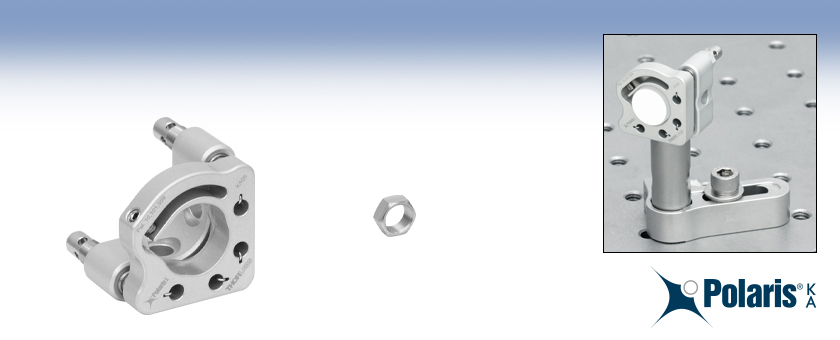
- Designed for Long-Term Stability
- Matched Actuator and Back Plate Threading Minimize Drift and Backlash
- Minimal Temperature-Dependent Hysteresis
- Sapphire Adjuster Seats Prevent Wear Over Time
KA05
Aluminum Front & Back Plates,
2 Adjusters with Side Holes
LN19100H
3/16"-100 Adjuster
Lock Nut
Application Idea
KA05 Ø1/2" Mirror Mount with Mirror
on a Ø1/2" Post for Polaris Mounts

Please Wait
| Quick Links |
|---|
| Ø1/2" Flexure Arm Mount |
| Hex Adjusters |
| Side Hole Adjustment Tool |
| Lock Nut & Torque Wrench |
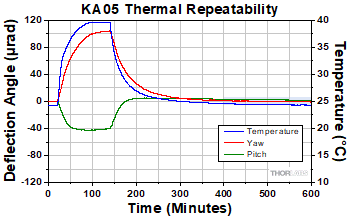
Click to Enlarge
Each Polaris mount undergoes extensive thermal testing to ensure high-quality performance. Please see the Test Data tab for additional test results.
Features
- Machined from Aged 7075 Aluminum Alloy for Exceptional Tensile Strength, Stiffness, Surface Toughness, and Dimensional Stability
- Hardened Stainless Steel Ball Contacts with Sapphire Seats for Durability and Smooth Movement
- Matched Actuator and Back Plate Provide Stability and Smooth Kinematic Adjustment
- Extensive Testing Guarantees Less than 4 μrad Deviation after 15 °C Temperature Cycling (See Test Data Tab for Details)
- Specialty Anodized Frames and Passivated Stainless Steel Adjusters Designed for use in High-Power Laser Cavity Applications
- Patented Optic Bore Design with Monolithic Flexure Arm (US Patent 10,101,559)
- Patent Pending Spring Design Reduces Contamination
- Mounting Holes Enable Left-Handed or Right-Handed Operation
- Custom Mount Configurations are Available by Contacting Tech Sales
The KA05 Polaris® KA Low-Drift Kinematic Mirror Mount features low-drift design considerations and clear-anodized 7075 aluminum construction, making it ideal for industrial applications requiring stringent long-term alignment stability.
Optic Retention
The KA05 Ø1/2" mirror mount features a patented optic bore design with a monolithic flexure arm to secure the optic. This design provides high holding force and pointing stability with minimal optic distortion. For more details, please see the Test Data tab.
Polaris optic bores are precision machined to achieve a fit that will provide optimal beam pointing stability over changing environmental conditions such as temperature changes, transportation shock, and vibration. Performance will be diminished if this mount is used with optics that have an outer diameter tolerance greater than zero or smaller metric optic sizes (Ø12.5 mm).
Design
Machined from aged 7075 aluminum alloy, the Polaris KA mount utilizes precision-matched adjusters with ball contacts and sapphire seats to provide smooth kinematic adjustment. As shown on the Test Data tab, this mount has undergone extensive testing to ensure high-quality performance. The Polaris design addresses all of the common causes of beam misalignment; please refer to the Design Features tab for detailed information.
Post Mounting
This Polaris mirror mount is equipped with #8 (M4) counterbores for post mounting. See the Usage Tips tab for more recommendations about mounting configurations.
Cleanroom and Vacuum Compatibility Notes
The aluminum front and back plates of the KA05 mount are acid etched, specialty anodized with a thin 5 µm oxide layer, duplex sealed with nickel, followed by boiling in reverse osmosis deionized (RODI) water. This process creates an all-metal surface that is clean, smooth, thin, hard, non-porous, and has a sealed oxide layer that supports use in low outgassing laser systems and cleanroom assembled systems. This same surface treatment is also used by some vacuum chamber manufacturers to prevent a native oxide layer from forming on the surface of bare aluminum. This surface finish provides an improvement over standard anodizing. For Polaris KA mounts, we recommend a maximum bake-out temperature of no more than 80 °C. For additional details, refer the Specs tab.
To further reduce outgassing rates in ultra-high vacuum (UHV) systems, we can provide mounts upon request with bare aluminum parts that are only acid etched; please contact Tech Sales with inquiries. Due to the reduction in surface hardness, these mounts will not have the same surface toughness, resulting in faster wear on the lens cells and adjuster screw threads. Such mounts would also need to be carefully handled and stored to prevent surface contamination and the formation of a native oxide layer. These custom mounts would support a maximum bake-out temperature of no more than 200 °C.
For the lowest outgassing rates in UHV systems, please consider the stainless steel Polaris line, which support a maximum bake-out temperature of no more than 200 °C.
| Item # | KA05 |
|---|---|
| Optic Sizea | Ø1/2" |
| Optic Thickness (Min) | 0.08" (2.0 mm) |
| Number of Adjusters | Two |
| Adjuster Drive | 5/64" Hex, Ø0.07" Side Adjustment Holes |
| Adjuster Thread | 3/16"-100 |
| Actuator Matching | Matched Actuator/Body Pairs |
| Measured Point-to-Point Mechanical Resolution per Adjuster (Bidirectional Repeatability) |
5 µrad (Typical); 2 µrad (Achievable) |
| Adjustment Resolutionb | ~14.3 mrad/rev |
| Mechanical Angular Range (Nominal) | ±4° |
| Front Plate Separation at Pivot Adjuster | 1.5 mm (Nominal) |
| Beam Deviationc After Thermal Cycling | <4 μrad |
| Recommended Optic Mounting Torqued | 8 - 12 oz-in for 6 mm Thick UVFS Optics |
| Mounting | Two #8 (M4) Counterbores at 90° |
| Cleaninge | Adjuster screws are passivated per ASTM-967; Frames are acid etched, anodized to MIL-A-8625, Type 2, Class 1, with a thin dense oxide layer and duplex sealed using nickel followed by boiling in reverse osmosis deionized (RODI) water. |
| Vacuum Compatibilityf | Grease Vapor Pressure: 10-13 Torr at 20 °C; 10-5 Torr at 200 °C Epoxy Meets Low Outgassing Standards NASA ASTM E595, Telcordia GR-1221 |
| Operating Temperature Range | -30 to 80 °C |
Polaris® Mirror Mounts Test Data
All Polaris Low-Drift Kinematic Mirror Mounts undergo extensive testing to ensure high-quality performance. Thermal shock testing confirms the exceptional stability of the mounts and demonstrates that they reliably return to their initial position after a transient temperature shift. Interferometric wavefront distortion testing demonstrates the ability of Polaris mounts to secure an optic without significantly distorting the optical surface.
Vibration Testing for Polaris Mounts (Ø19 mm Polaris Mount Shown)
Vibration Testing
Purpose: This testing was done to determine how reliably Polaris mirror mounts behave when subjected to intense physical vibrations.
Procedure: A pair of identical KA05 mirror mounts were mounted on Ø1" Posts for Polaris Mirror Mounts and secured to a stainless steel breadboard with POLARIS-CA1 clamping arms. Laser beams were reflected from the mirrors onto two position sensing detectors, located on the same breadboard. The entire platform was vibrated with a variable frequency and amplitude and the displacement of the beam on the detector was recorded. The two beam paths were oriented at right angles so that the vibrational motion was in a direction parallel to the face of one mount and perpendicular to the face of the other. Please see the video to the right for a demonstration of our Polaris vibration test (the mount shown in the video is the POLARIS-K19S4 Ø19 mm mount).
Results: When subjected to vibrational frequencies from 5 to 500 Hz and accelerations as high as 6 g, the KA05 mounts remained mechanically sound. The angular position of the mounts remained stable within about 10 µrad for both parallel and perpendicular vibrations.
Conclusions: Our KA05 Polaris mirror mounts provide exceptional performance, even under rugged operating conditions. As a result, these mounts are ideal for use in systems that require the greatest degree of stability when vibrational noise is expected.
Positional Repeatability After Thermal Shock
Purpose: This testing was done to determine how reliably the mount returns the mirror, without hysteresis, to its initial position. These measurements show that the alignment of the optical system is unaffected by the temperature shock.
Procedure: After mounting the KA05 mount to a Ø1" Post, the mirror and post assembly was secured to a stainless steel optical table in a temperature-controlled environment. The mirror was held using the flexure mechanism; see the Usage Tips tab for additional mounting recommendations. A beam from an independently temperature-stabilized laser diode was reflected by the mirror onto a position sensing detector. The temperature of each mirror mount tested was raised to at least 37 °C. The elevated temperature was maintained in order to soak the mount at a constant temperature. Then the temperature of the mirror mount was returned to the starting temperature. The results of these tests are shown below.
Results: As can be seen in the plots below, when the mount was returned to its initial temperature, the angular position (both pitch and yaw) of the mirrors returned to within 4 µrad of its initial position. The performance of the Polaris mount was tested further by subjecting the mount to repeated temperature change cycles. After each cycle, the mirror’s position reliably returned to within 4 µrad of its initial position.
For Comparison: To get a 4 µrad change in the mount’s position, the 3/16"-100 threaded adjuster on the KA05 Polaris mount needs to be rotated by only 0.1° (1/3575 of a turn). A highly skilled operator might be able to make an adjustment as small as 0.3° (1/1200 of a turn), which corresponds to a 12 µrad change in the mount's position.
Conclusions: Polaris Mirror Mounts are high-quality, ultra-stable mounts that will reliably return a mirror to its original position after cycling through a temperature change. As a result, Polaris mounts are ideal for use in applications that require long-term alignment stability.
 Click to Enlarge Thermal Repeatability for KA05 Polaris Mirror Mount with 2 Side-Hole Hex Adjusters |
 Click to Enlarge The plot above shows the final angular position of the KA05 mount for 10 consecutive thermal shock tests. The change in temperature is the difference between the starting temperature and the temperature at the end of the test and includes factors such as the variation in room and mount temperature. |
Optical Distortion Testing Using a ZYGO Phase-Shifting Interferometer
Mounting stresses are responsible for the strain that results in optical surface distortion. Minimizing distortion effects is crucial; any distortion to the optic affects the reflected wavefront. The KA05 Polaris mount sold below features a monolithic flexure arm that is designed to provide maximum stability while minimizing optic distortion.
To determine the amount of optic distortion exerted on the mirror by the flexure arm, a ZYGO Phase-Shifting Interferometer was used to measure the wavefront distortion at different torque angles (see screenshots of the Zygo testing runs by clicking on the links in the table below to the right). Based on results of the tests, we recommend turning the setscrew 20 to 30° clockwise after initial contact, at which point the optic wavefront distortion is ≤0.1λ.
Please note that the optimal optic mounting torque can vary due to variations in optic diameter and tolerance buildup.
Procedure:
A broadband dielectric mirror was installed into a Polaris mount using the setscrew to clamp down the flexure arm. The setscrew was engaged until the flexure arm initially made contact, then was turned clockwise by a number of degrees. Measurements of the optic distortion were then recorded using the ZYGO interferometer. Once each measurement was complete, the amount of force needed to push the optic out of the mount was measured to check optic retention. The wavefront distortion values shown in the upper left of the screenshots give peak-to-valley distortion across the entire optic, representing the worst-case scenario; the center of the optic exhibits significantly less distortion than the edge.
Results:
As seen in the table below, the peak-to-valley wavefront distortion was found to be ≤0.1λ when the setscrew was turned 20 to 30° clockwise after initial contact. This provides a safety margin over a 10° torque angle to ensure the mount maintains good contact with temperature changes and thermal expansion of the mount.
| Wavefront Distortion for a Ø1/2" Mirror in a KA05 Polaris Mount | ||
|---|---|---|
| Torque Anglea |
Wavefront Distortion (Peak to Valley)b (Click for Example Zygo Screenshot) |
Push-Out Forcec |
| 10° | 0.062λ | >5 lbf |
| 20° | 0.072λ | |
| 30° | 0.081λ | |
| 40° | 0.094λ | |
| 50° | 0.110λ | |
| 60° | 0.123λ | |
| 70° | 0.143λ | |
| 80° | 0.154λ | |
| 90° | 0.151λ | |
| 100° | 0.164λ | |
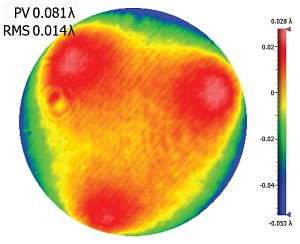
Click to Enlarge
KA05 Wavefront Distortion with Setscrew Turned
30° Clockwise After Initial Contact
(See Table to the Right for Other Setscrew Torques)
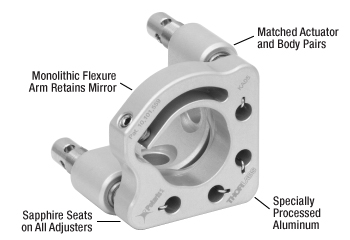
Click to Enlarge
Details of the KA05 Mount Design
Several common factors typically lead to beam misalignment in an optical setup. These include temperature-induced hysteresis of the mirror's position, crosstalk, drift, and backlash. Polaris mirror mounts are designed specifically to minimize these misalignment factors and thus provide extremely stable performance. Hours of extensive research, multiple design efforts using sophisticated design tools, and months of rigorous testing went into choosing the best components to provide an ideal solution for experiments requiring ultra-stable performance from a kinematic mirror mount.
Thermal Hysteresis
The temperature in most labs is not constant due to factors such as air conditioning, the number of people in the room, and the operating states of equipment. Thus, it is necessary that all mounts used in an alignment-sensitive optical setup be designed to minimize any thermally induced alignment effects. All the critical components of the Polaris KA series mirror mounts are made from specially selected dimensionally stable materials, such as low stress aged round 7075 aluminum bar stock to reduce internal stresses that can cause temperature-dependent hysteresis and optimal material tempers to improve the material stiffness and strength. As a result, the alignment of the optical system will be restored when the temperature of the mirror mount is returned to the initial temperature.
The method by which the mirror is secured in the mount is another important design factor for Polaris KA series mounts; these mounts offer excellent performance without the use of adhesives. Instead, the mounts offered on this page use a monolithic flexure arm that is pressed onto the edge of the mirror using a setscrew. Setscrews, when used by themselves to hold an optic, tend to move as the temperature changes. In contrast, the holding force provided by the aluminum flexure arm is sufficient to keep the mirror locked into place regardless of the ambient temperature.
Crosstalk
Crosstalk is minimized by carefully controlling the dimensional tolerances of the front and back plates of the mount so that the pitch and yaw actuators are orthogonal. In addition, sapphire seats are used at all three contact points. Standard metal-to-metal actuator contact points will wear down over time. The polished sapphire seats of Polaris KA series mounts, in conjunction with the hardened stainless steel actuator tips, maintain the integrity of the contact surfaces over time.
Drift and Backlash
In order to minimize the positional drift of the mirror mount and backlash, it is necessary to limit the amount of play in the adjuster as well as the amount of lubricant used. When an adjustment is made to the actuator, the lubricant will be squeezed out of some spaces and built up in others. This non-equilibrium distribution of lubricant will slowly relax back into an equilibrium state. However, in doing so, this may cause the position of the front plate of the mount to move. Polaris KA series mounts use adjusters matched to the body or bushings that exceed all industry standards so very little adjuster lubricant is needed. As a result, alignment of these mounts is extremely stable even after being adjusted (see the Test Data tab for more information). In addition, these adjusters have a smooth feel that allows the user to make small, repeatable adjustments.
Cleanroom and Vacuum Compatibility
The front and back plates of the KA05 mount are machined from aged 7075 aluminum alloy for exceptional tensile strength, stiffness, surface toughness, and dimensional stability. They are then acid etched, specialty anodized with a thin 5 µm oxide layer, and duplex sealed with nickel, followed by boiling in reverse osmosis deionized (RODI) water. This process creates an all-metal surface that is clean, smooth, thin, hard, non-porous, and has a sealed oxide layer that supports use in low outgassing laser systems and cleanroom assembled systems. This same surface treatment is also used by some vacuum chamber manufacturers to prevent a native oxide layer from forming on the surface of bare aluminum. This surface finish provides an improvement over standard anodizing. For Polaris KA series mounts, we recommend a maximum bake-out temperature of no more than 80 °C.
To further reduce outgassing rates in ultra-high vacuum (UHV) systems, we can provide mounts upon request with bare aluminum parts that are only acid etched; please contact Tech Sales with inquiries. Due to the reduction in surface hardness, these mounts will not have the same surface toughness as the fully processed KA05 mounts, resulting in faster wear on the lens cells and adjuster screw threads. Such mounts would also need to be carefully handled and stored to prevent surface contamination and the formation of a native oxide layer. These custom mounts would support a maximum bake-out temperature of no more than 200 °C.
For the lowest outgassing rates in UHV systems, please consider the stainless steel Polaris products which support a maximum bake-out temperature of no more than 200 °C.
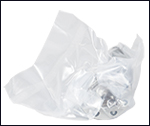
Click to Enlarge
All Polaris mounts are shipped inside two vacuum bag layers.
The sapphire contacts are bonded into place using a NASA-approved low outgassing procedure. In addition, DuPont LVP High-Vacuum (Krytox) Grease, an ultra-high vacuum compatible, low outgassing PTFE grease, is applied to the adjusters. These features provide high vacuum compatibility and low outgassing performance. When operating at pressures below 10-5 Torr, we highly recommend using an appropriate bake out procedure prior to installing the mount in order to minimize contamination caused by outgassing. Please note that the 8-32 and M4 cap screws included with the Polaris mounts are not rated for pressures below 10-5 Torr.
Cleanroom-Compatible Packaging
Each vacuum-compatible Polaris mount is packaged within two vacuum bag layers after assembly in a clean environment, as seen in the image to the right. The vacuum-tight fit of the bags stabilizes the mount, limiting translation of the front plate due to shocks during transportation. The tight fit also minimizes rubbing against the bag, preventing the introduction of bag material shavings that would contaminate the clean mount.
In the vacuum-sealing process, moisture-containing air is drawn out of the packaging. This eliminates unwanted reactions on the surface of the mount without the need for desiccant materials. The vacuum bags protect the mount from contamination by air or dust during transport and storage, and the double-vacuum bag configuration allows for a straightforward and effective cleanroom entry procedure. The outer bag can be removed outside of the cleanroom, allowing the contaminant-free inner bag to be placed into a clean container and transferred into the cleanroom while retaining the benefits of vacuum-bag packaging. Inside the cleanroom, the mount can be removed from the inner bag when ready for use.
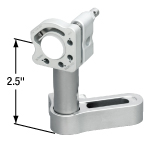
Click to Enlarge
The KA05 mount can be mounted to a surface using a Ø1/2" Post for Polaris Mirror Mounts and a Polaris Clamping Arm. Using a 2" long post, the optical axis is 2.5" above the table surface.

Click to Enlarge
The shaded region in this plot denotes the recommended torque angle for a 6 mm thick optic in the KA05 mount. Over torquing the monolithic flexure arm past the recommended past this range can result in a significant increase in the surface distortion of mounted optics.
Through thermal changes and vibrations, the KA05 Polaris® kinematic mirror mount is designed to provide years of use. Below are some usage tips to ensure that the mount provides optimal performance.
Match Materials
When mounting the KA05 mount, we recommend using Ø1/2" or Ø1" Posts for Polaris Mirror Mounts and a Polaris Clamping Arm. If not available, we recommend mounting to aluminum components.
Use a Wide Post
The KA05 mount's performance is optimized for use with our posts for Polaris mounts and our Polaris clamping arm. These posts are made of stainless steel and provide two lines of contact with the mount, which help confine the bottom of the mount during variations in the surrounding temperature, thereby minimizing potential alignment issues.
Optic Mounting
Since an optic is prone to movement within its mounting bore, all optics should be mounted with the Polaris out of the setup to ensure accurate mounting that will minimize misalignment effects. We recommend tightening the setscrew past initial contact with the optic to a torque angle of 20° to 40°, as recommended in the Test Data tab. Over torquing the monolithic flexure arm optic retainer past the recommended range can result in a significant increase in the surface distortion of mounted optics (see the graph below and to the right).
Front Plate’s Position
The KA05 mount is designed to allow adjustments of up to 8°. To achieve the best performance, it is recommended that the front plate be kept as parallel as possible to the back plate. This ensures the highest stability of the adjustments.
Mount as Close to the Table’s Surface as Possible
To minimize the impact of vibrations and temperature changes, it is recommended that your setup has as low of a profile as possible. Using short posts will reduce the Y-axis translation caused by temperature variations and will minimize any movements caused by vibrations. The mount can also be secured directly to an optical table or breadboard using a 1/4"-20 to 8-32 thread adapter (Item # AE8E25E) or M6 x 1.0 to M4 x 0.7 thread adapter (Item # AE4M6M). By doing so, the instability introduced by a post will be eliminated. The KA05 mount would perform best when mounted directly to an aluminum base plate.
Polish and Clean the Points of Contact
We highly recommend that the points of contact between the mount and the post, as well as the post and the table, are clean and free of scratches or defects. For best results, we recommend using a polishing stone to clean the table’s surface and an LF1P polishing pad for the top and bottom of the post as well as the bottom of the mount.
Use Polaris-Specific Adjustment Tools
The SA1 Adjustment Tool features a precision fit tip that is designed for the 0.07" side-hole adjusters used in the KA05 mount. Additionally, its handle includes a 5/64" (2.0 mm) hex which is compatible with the hex on the end of each adjuster screw. For KA05 mounts which are exposed to shock and vibration, Thorlabs offers the LN19100H 3/100"-100 Lock Nut. In situations where frequent adjustment is the required, the LN19100H lock nut can be hand-tightened with a torque of 4 to 8 oz-in (0.03 to 0.06 N•m). If long-term stability is required, the TW6 Torque Wrench can be used to tighten the lock nuts with 25 oz-in of torque.
Not Recommended
We do not recommend taking the adjusters out of the back plate, as it can contaminate the threading. This can reduce the fine adjustment performance significantly. Also, do not pull the front plate away as it might stretch the springs beyond their operating range or crack the sapphire seats. Finally, do not over tighten the retaining screws that secure the flat spring that holds the optic in place; only slight force is required to secure the optic in place.
| Posted Comments: | |
user
(posted 2025-02-04 10:00:52.72) I don't believe that this aluminum mount has exact same behavior in thermal testing as per its steel companion.
I highly doubt this thermal testing results. .
Please retest again for repeatability.
this looks like false marketing.! jdelia
(posted 2025-02-04 01:13:24.0) Thank you for contacting Thorlabs. Unfortunately, you did not provide an email address at which to contact you. This product has in fact been tested extensively. We cannot provide comment beyond that at this time since you have not provided any specific reasons as to why you suspect the data to be incorrect. If you would like to have a more in-depth discussion about this, you can reach out to your local tech support team. |

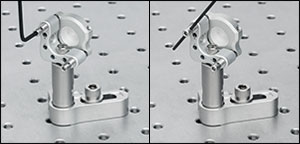
Click to Enlarge
Methods of Adjusting the KA05 Ø1/2" Mount:
Left: 5/64" or 2.0 mm Hex Key in the End of the Adjuster
Right: Same Hex Key Through Adjuster Side Holes
- 2 Hex Adjusters with Side Holes (See Image to the Right)
- Designed for use with Ø1/2" Optics
- 3/16"-100 Threaded Matched Actuator/Body Pairs
- ±4° Mechanical Angular Range (Nominal)
- ~14.3 mrad/rev Resolution
- Less than 4 µrad Deviation after Temperature Cycling
(See the Test Data Tab for Details) - Patented Monolithic Flexure Arm Design for Minimal Optic Distortion and Improved Optic Holding Stability (US Patent 10,101,559, See the Test Data Tab for Details)
- Patent Pending Spring Design Reduces Contamination
The KA05 2-Adjuster Ø1/2" Polaris Kinematic Mirror Mount is designed to provide easy high-resolution adjustment and the long-term alignment stability needed in industrial applications. The mount features a monolithic flexure arm that can be actuated using the included screw and a 0.05" (1.3 mm) hex key. The monolithic flexure arm design keeps wavefront distortion on the mounted optic to a minimum while providing a strong optic retention force. See the Test Data tab for more information on the distortion of the optic caused by the monolithic flexure arm. The 2-adjuster design improves mount stability by limiting the available degrees of freedom for movement, making this mount an ideal solution for OEM applications that require reliable operation in rugged environments.
The 3/16"-100 threaded adjusters feature two Ø0.07" (Ø1.8 mm) through holes that allow for actuation from the side using our precision-fit SA1 Side Hole Adjustment Tool (sold below) or a 1/16" (1.5 mm) balldriver or hex key. Each adjuster also has a 5/64" (2.0 mm) hex and may be adjusted with the hex on the end of the SA1, our HKTS-5/64 Hex Key Thumbscrews (sold below), or any other 5/64" (2.0 mm) hex wrench. The adjusters on this mount can be locked using LN19100H lock nuts (sold below).
Post mounting is provided by two #8 (M4) counterbores at 90°. We recommend using this mount with a stainless steel Ø1/2" or Ø1" Post for Polaris mounts.

- For Convenient Adjustment of 5/64" and 2 mm Hex-Driven Actuators
- Red Anodized Adjustment Knob with Engraved Hex Size
- Replaceable Hex Tip
- Sold in Packages of 4
These 5/64" Hex Key Adjuster Thumbscrews allow for quick adjustment of many 5/64" and 2 mm hex-driven actuators (or standard actuators with the knobs removed). These temporary knobs can be left in the screw's hex socket between adjustments for convenience (see photo to the right). An 8-32 setscrew (5/64" hex) secures the replaceable hex bit, which can be reversed if the tip is stripped. Contact Tech Support to order replacement hex key bits.
We offer hex key thumbscrews in sizes from 0.050" to 3/16" and 2 mm to 5 mm.

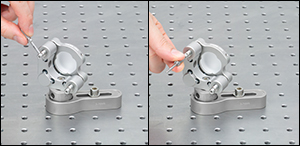
Click to Enlarge
The SA1 tool can be used to adjust a POLARIS-K1S4 mount using the side holes (left) or rear hex (right).
- Ø0.07" Precision-Fit Tip for Side Holes on Polaris Adjusters
- 5/64" (2.0 mm) Hex on Handle
- Magnetic, Chemically Cleaned Stainless Steel
The Side Hole Adjustment Tool features a Ø0.07" precision-fit tip designed for Polaris mounts with side hole adjusters. The handle features a 5/64" (2.0 mm) hex allowing the SA1 to act as a small knob, and the central nut is compatible with a 6.0 mm wrench allowing for a longer lever arm. The precision-fit tip minimizes backlash during adjustments and the depth stop allows the tool to rest securely in a side hole between adjustments. On Ø25 mm mirror mounts and larger, the 1.62" length allows the tool to adjust the actuator 360° without interfering with the other adjuster on the back of the mount.
The SA1 is made of chemically cleaned, hardened, super alloy stainless steel for durability and compatibility with clean environments. The tool is also magnetic allowing it to be easily retrieved from tight or sensitive setups using a magnet.

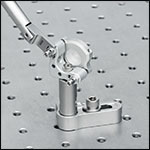
Click to Enlarge
TW6 Torque Wrench Used to Secure LN19100H Lock Nut on KA05 Mirror Mount

Click to Enlarge
The TW6 wrench is engraved with its preset torque value and Item #.
- LN19100H 3/16"-100 Aluminum Lock Nut Provides Long Term Adjuster Stability
- TW6 Torque Wrench Ideal for Applications Requiring Long-Term Locking
- Preset 24 oz-in Torque Value
- Break-Over Design Ensures Proper Torque is Applied
The LN19100H Lock Nut is designed for use with Polaris KA mounts that have 3/16"-100 adjusters in applications that require long-term adjuster stability or setups that are exposed to shock and vibration; note that the lock nut should not be used with low-profile adjuster mounts. It is made of the same aluminum alloy with the same preparation methods as the KA05 mount (refer to the Specs tab for details).
For applications that require frequent tuning of the adjusters, this lock nut only needs to be lightly tightened by hand to a torque of approximately 4 to 8 oz-in (0.03 to 0.06 N·m). If long term stability is required, the TW6 torque wrench below can be used to apply 24 oz-in (0.17 N·m) of torque to each lock nut. To avoid cross threading the lock nut, place it against the adjuster and "unscrew" the lock nut until you feel a slight drop; then thread the lock nut onto the adjuster.
Preset Torque Wrench
This torque wrench has a preset torque value to secure 6 mm lock nuts on Polaris mounts for long-term locking; see the table below for specifications. When the preset torque value has been achieved, the break-over design will cause the pivoting joint to "break," as shown to the right. The wrench's hex head will move back into place once the force is removed. This design prevents further force from being applied to the lock nut. Engraved guidelines indicate the angle the wrench should pivot in order to apply the specified torque; pivoting the handle past these guidelines will over-torque the lock nut. The wrench is also engraved with its preset torque value, torque direction, wrench size, and Item # for easy identification in the field.
This wrench is designed to be compatible with cleanroom and vacuum chamber applications. It is chemically cleaned using the Carpenter AAA passivation method to remove sulfur, iron, and contaminants from the surface. After passivation, it is assembled in a clean environment and double vacuum bagged to eliminate contamination when transported into a cleanroom. Finally, it is bead blasted to minimize reflections when working with setups that include lasers.
Please note that this wrench is not intended for use in applications where adjusters are frequently tuned, as these applications typically require torque values of 4 to 8 oz-in (0.03 to 0.06 N·m).
| Item # | Torque | Torque Accuracy | Hex | Compatible Items |
|---|---|---|---|---|
| TW6 | 24 oz-in (0.17 N•m) | ±1.44 oz-in (0.010 N•m) | 6 mm | LN19100H 3/16"-100 Aluminum Lock Nut, POLARIS-LN05 3/16"-130 Stainless Steel Lock Nut |
 Products Home
Products Home







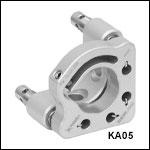
 Zoom
Zoom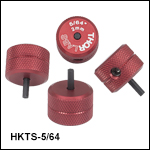
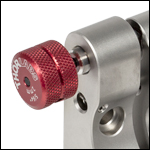
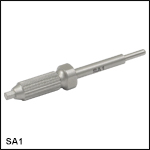

 Ø1/2" Side Optic Retention Mount, Aluminum
Ø1/2" Side Optic Retention Mount, Aluminum